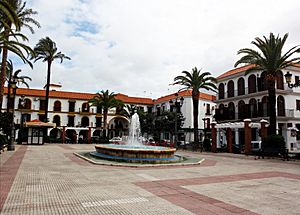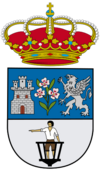Lepe facts for kids
Quick facts for kids
Lepe
|
|||
|---|---|---|---|

Plaza España, Lepe
|
|||
|
|||
| Country | Spain | ||
| Autonomous community | Andalusia | ||
| Province | Huelva | ||
| Comarca | Costa Occidental | ||
| Area | |||
| • Total | 129 km2 (50 sq mi) | ||
| Elevation | 18 m (59 ft) | ||
| Population
(2018)
|
|||
| • Total | 27,047 | ||
| • Density | 209.7/km2 (543.0/sq mi) | ||
| Demonym(s) | Leperos | ||
| Time zone | UTC+1 (CET) | ||
| • Summer (DST) | UTC+2 (CEST) | ||
Lepe is a town in Spain, located in the province of Huelva. It is part of the Andalusia region. Lepe is close to the border with Portugal. In 2022, about 28,617 people lived there.
Contents
Lepe's Economy
For a long time, Lepe's economy was mostly about fishing. But by the late 1970s, things changed a lot.
Strawberry Farming
Today, Lepe is famous for its huge farms that grow strawberries. These farms use special methods to grow a lot of strawberries. Lepe exports these strawberries all over Europe. This has made Lepe one of the richest towns in its region.
Lepe's History
People have lived in the area around Lepe since the Stone Age. But there is no clear proof of big, permanent towns back then.
Roman Times
During the early Roman period, Lepe was a small country estate. There were also fish farms nearby. Over time, the coastline changed, and some settlements were left behind. But fishing continued in the area of El Terrón.
Later, during the main Roman period, Lepe grew into a small village. It was connected to farming and the fishing port of El Terrón. Historians believe Lepe might have been called Laepa by the Romans.
Arab Rule
Lepe became very important after the second wave of Arab conquests. It grew from a small farm area to a "city about the Ocean Sea." This is how a geographer described it in 1229. The name Labb was used during Arab rule, which later became the name Lepe we use today.
Age of Exploration
Some people from Lepe played a part in Christopher Columbus's journey to the Americas. A sailor named Rodrigo de Triana was the first person to see the coast of the Americas.
Later, in the late 1500s, a man named Marcos Alonso de la Garza left Lepe. He moved to what is now Durango, a state in Mexico. His family line includes important people like Cpt. Blas María de la Garza Falcón.
Main Sights in Lepe
Lepe has several interesting places to visit.
Iglesia de Santo Domingo de Guzmán
In the town, you can find the Iglesia de Santo Domingo de Guzmán. This church was built in the 1300s. It has a special style called Mudéjar. Inside, you can see the statue of the Virgen de la Bella, who is Lepe's patron saint.
Ermita de Nuestra Señora de la Bella
Just outside Lepe, there is a hermitage called Ermita de Nuestra Señora de la Bella. It is also from the 1300s and is dedicated to the Virgin. Every year, on the second Saturday in May, there is a special event. People carry the statue of the Virgen de la Bella from the church to the hermitage.
Torre del Catalán
The Torre del Catalán is a lookout tower built in the 1500s. King Philip II of Spain ordered it to be built. Its purpose was to warn people about pirates from North Africa. You can climb the tower for amazing views. From the top, you can see a nature reserve called Paraje Natural Marismas del Río Piedras y la Flecha de Nueva Umbria.
Beaches and Ports
Lepe's main beach is La Antilla. It is about 5 kilometers south of the town. Another place is El Terrón, a small fishing port. It is located between La Antilla and Lepe. From El Terrón, you can enjoy great views of El Rompido. You can also see the nature reserve of the Marismas del Río Piedras.
Lepe's Wines
Did you know that Lepe's wines were once very famous? They were even sent to England in the Middle Ages. The famous writer Chaucer mentioned them in his book, The Canterbury Tales.
Sport in Lepe
Lepe is home to a football team called San Roque de Lepe. They play in the third division of Spanish football. The team plays their games at the Estadio Ciudad de Lepe. This stadium was built especially for the team in 2011.
Twin Towns
Lepe has friendly connections with other towns around the world. These are called "twin towns."
See also
 In Spanish: Lepe para niños
In Spanish: Lepe para niños




